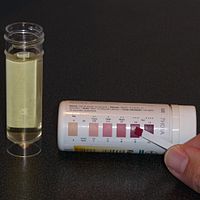
Photo from wikipedia
One in four toddlers are not achieving the recommended vitamin D intake crucial for their healthy development(1, 2). This study explored parents’ acceptability of factors affecting purchasing of foods and… Click to show full abstract
One in four toddlers are not achieving the recommended vitamin D intake crucial for their healthy development(1, 2). This study explored parents’ acceptability of factors affecting purchasing of foods and drinks fortified with Vitamin D in children aged 0-2 years old. A total of 194 parents completed an online parent questionnaire. Focus groups and interviews were used to explore in depth perceptions of vitamin D fortification. Thirteen participants participated in the 5 focus groups, 5 completed interviews. The majority of participants were female (mothers) and of White-British ethnic background, aged between 25-40 years, with 89% of the sample with a level 3 qualification (e.g. 2 or more A levels, NVQ level 3). Basic descriptive statistics were calculated from the questionnaire data and a thematic analysis methodology was applied to the qualitative data. The findings indicated low purchasing of vitamin D fortified foods/drinks by parents (21% of the sample). The foods/drinks most purchased were cereal, yogurts and alternative milks. Willingness to purchase certain products fortified with vitamin D to increase their child’s vitamin D was however high. After excluding formula milk, parents would be willing to buy yogurt, yogurt drinks, cereals, milk-based drinks, fruit juice and margarine. The table outlines parents’ views on the facilitators and barriers to purchasing vitamin D fortified foods and drinks. There is a potential for fortified foods to play a role in increasing the intake of vitamin D intake. Parents need quality education explaining the need to prevent vitamin D deficiency, though fortified products. Products also need to be suitable for babies and toddlers; better labelled, lower cost; with healthy options available with lower sugar and salt content, tasty, longer shelf life and better availability in local shops and supermarkets. Future research should determine if consumption of fortified foods/drinks alone rather than supplementation is sufficient to meet children’s daily intake of vitamin D(3).
Journal Title: Proceedings of the Nutrition Society
Year Published: 2018
Link to full text (if available)
Share on Social Media: Sign Up to like & get
recommendations!